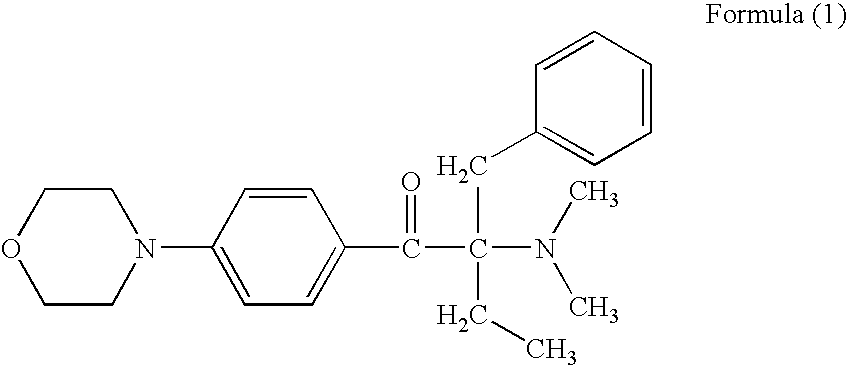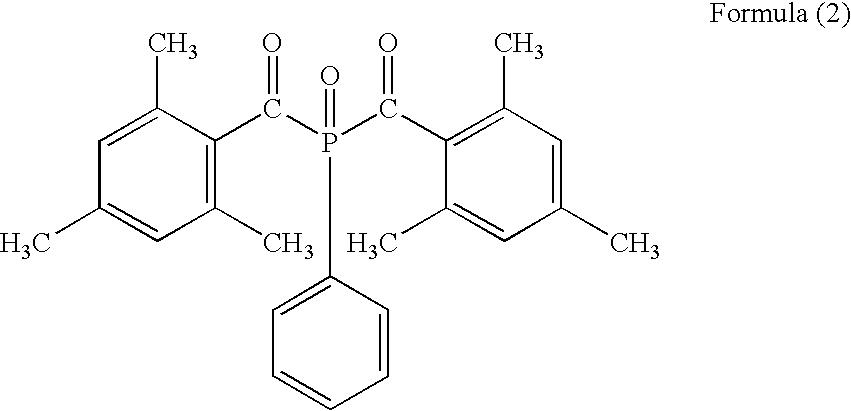UV-curable pressure-sensitive adhesive composition and its pressure-sensitive adhesive sheet
a technology of pressure-sensitive adhesives and compositions, applied in the direction of film/foil adhesives, non-macromolecular adhesive additives, transportation and packaging, etc., can solve the problems of low absorption wavelength efficiency of initiators and insufficient curing, and achieve sufficient curing performance, not taking long hours for curing, and good reaction efficiency of photoinitiators
- Summary
- Abstract
- Description
- Claims
- Application Information
AI Technical Summary
Benefits of technology
Problems solved by technology
Method used
Image
Examples
example 1
[0030]By copolymerization of 95 parts of n-butyl acrylate and 5 parts of acrylic acid in a conventional manner, a solution containing the acrylic polymer having a weight-average molecular weight of 1,000,000 was obtained. To the resulting solution, were added 60 parts of dipentaerythritol hexaacrylate as a polymerization component, 3 parts [corresponding to 1.79 wt. % of the whole pressure-sensitive adhesive composition (solid content)] of 2-benzyl-2-dimethylamino-1-(4-morpholinophenyl)-butanone-1 (having a molar absorptivity of 1,500 mol−1·cm−1 at a light wavelength of 365 nm and the maximum absorption wavelength of 435 nm on a long wavelength side) as a photoinitiator and 5 parts of a polyisocyanate compound [“Colonate L”, trade name; product of Nippon Polyurethane) as a crosslinking agent. The resulting mixture was dissolved in a toluene solvent to prepare a solution of a UV-curable pressure-sensitive adhesive composition. The resulting solution was applied to the surface of a 10...
example 2
[0031]By copolymerization of 60 parts of n-butyl acrylate, 10 parts of methyl methacrylate and 30 parts of 2-hydroxyethyl acrylate, an acrylic polymer having a weight-average molecular weight of 400,000 was obtained. The resulting polymer was reacted with 7.5 parts of methacryloyloxyethyl isocyanate to yield a reactive acrylic polymer having, at the side chain thereof, a carbon-to-carbon double bond. To 100 parts of the resulting reactive acrylic polymer, were added 1 part [corresponding to 1 wt. % of the whole pressure-sensitive adhesive composition (solid content)] of 2-benzyl-2-dimethylamino-1-(4-morpholinophenyl)-butanone-1 as a photoinitiator and 0.5 part of a polyisocyanate compound [“Colonate L”, similar to Example 1) as a crosslinking agent. The resulting mixture was dissolved in a toluene solvent to prepare a solution of a UV-curable pressure-sensitive adhesive composition. The resulting solution was applied to the surface of a 100 μm thick polyester film (one side subjecte...
example 3
[0032]In a similar manner to Example 1 except for the use of 3 parts [corresponding to 1.79 wt. % of the whole pressure-sensitive adhesive composition (solid content)] of bis(2,4,6-trimethylbenzoyl)-phenylphosphine oxide (having a molar absorptivity of 5,000 mol−1·cm−1 at a light wavelength of 365 nm and the maximum absorption wavelength of 445 nm on a long wavelength side) as a photoinitiator, a solution of a UV-curable pressure-sensitive adhesive composition was prepared. As in Example 1, the resulting solution was used to produce a pressure-sensitive adhesive sheet.
PUM
| Property | Measurement | Unit |
|---|---|---|
| absorption wavelength | aaaaa | aaaaa |
| absorption wavelength | aaaaa | aaaaa |
| wavelength | aaaaa | aaaaa |
Abstract
Description
Claims
Application Information
 Login to View More
Login to View More - R&D
- Intellectual Property
- Life Sciences
- Materials
- Tech Scout
- Unparalleled Data Quality
- Higher Quality Content
- 60% Fewer Hallucinations
Browse by: Latest US Patents, China's latest patents, Technical Efficacy Thesaurus, Application Domain, Technology Topic, Popular Technical Reports.
© 2025 PatSnap. All rights reserved.Legal|Privacy policy|Modern Slavery Act Transparency Statement|Sitemap|About US| Contact US: help@patsnap.com


